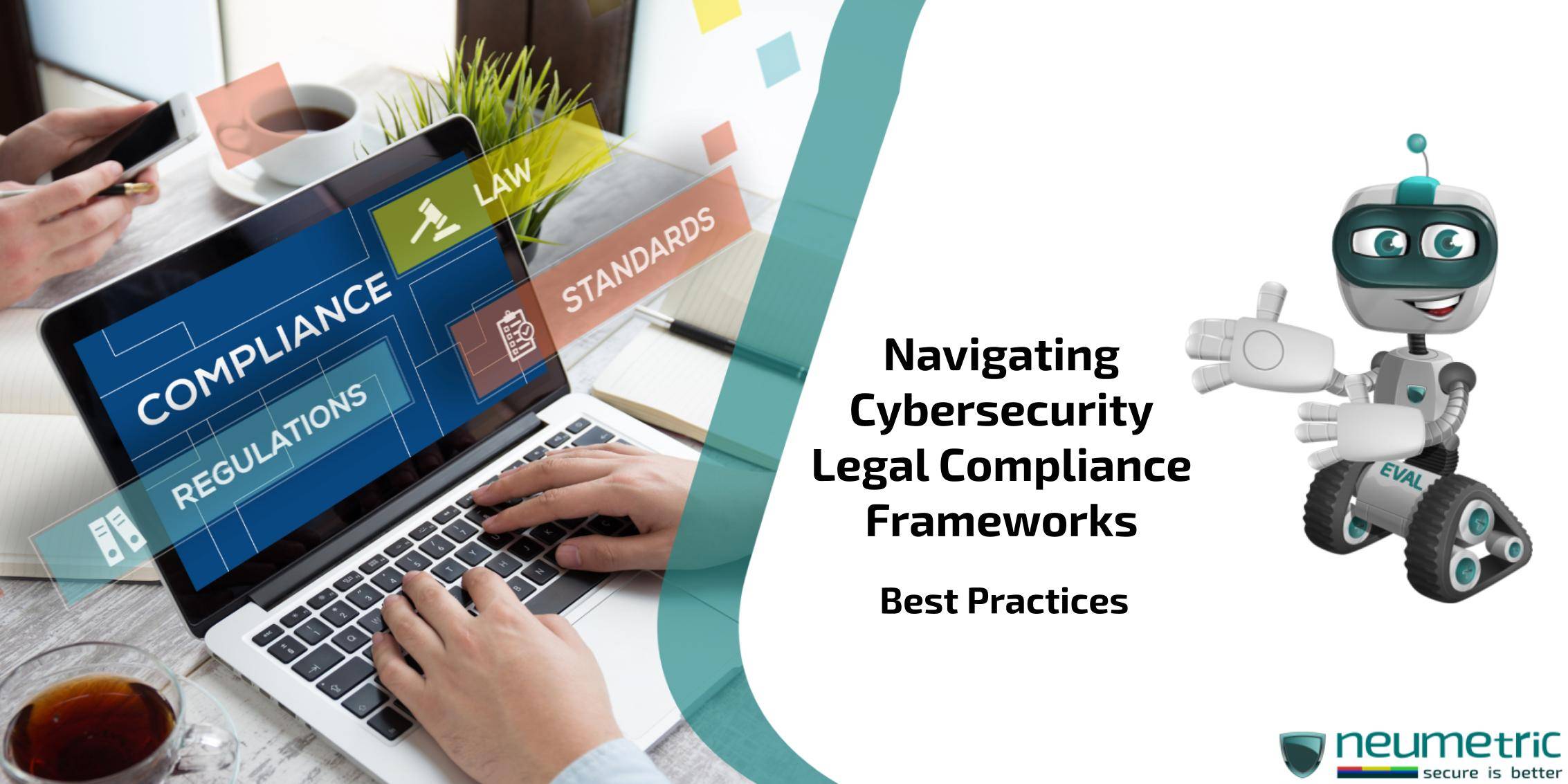Table of Contents
ToggleNavigating Cybersecurity Legal Compliance Frameworks: Best Practices
Introduction
In today’s rapidly evolving digital landscape, the surge in cyber threats has become a pressing concern for individuals, businesses & governments alike. The need for robust cybersecurity measures is more critical than ever, as the repercussions of a cyberattack can be both financially & operationally devastating. This Journal delves into the intricate realm of cybersecurity legal compliance frameworks, offering insights & best practices to navigate this complex terrain.
To set the stage, let’s acknowledge the growing frequency & sophistication of cyber threats that transcend traditional security measures. As organisations strive to safeguard their assets & sensitive information, adherence to cybersecurity legal compliance frameworks emerges as a crucial aspect of their defence strategy.
This Journal is structured to guide readers through the labyrinth of cybersecurity legal compliance, providing a comprehensive understanding of best practices. We’ll explore the importance of compliance, shed light on existing frameworks & offer actionable insights to enhance cybersecurity posture. By the end of this exploration, you’ll be equipped with the knowledge to fortify your organisation against cyber threats while ensuring adherence to legal standards. Let’s embark on this journey to fortify the digital realm together.
Understanding Key Cybersecurity Compliance Frameworks
Understanding the key cybersecurity compliance frameworks is pivotal in establishing a robust defence against the ever-evolving landscape of cyber threats. Let’s delve into the core pillars of some prominent frameworks that organisations often grapple with to ensure the security of their digital ecosystems.
- Health Insurance Portability & Accountability Act [HIPAA]: Primarily applicable to the healthcare sector, HIPAA sets standards for protecting sensitive patient data. Compliance involves implementing safeguards, conducting risk assessments & ensuring secure data transmission.
- Payment Card Industry Data Security Standard [PCI DSS]: Vital for businesses handling Cardholder information, PCI DSS outlines security requirements to prevent data breaches. From secure networks to regular monitoring, compliance is a multifaceted approach to safeguard financial transactions.
- Sarbanes-Oxley Act [SOX]: Focused on financial data integrity, SOX mandates controls to prevent corporate fraud. This framework ensures accurate financial reporting through stringent measures, promoting transparency & accountability.
- General Data Protection Regulation [GDPR]: Extending its influence globally, GDPR safeguards personal data. Organisations must acquire explicit consent for data processing, notify breaches promptly & appoint a Data Protection Officer, ensuring a privacy-centric approach.
- California Consumer Privacy Act [CCPA]: Predominantly affecting businesses operating in California, CCPA empowers consumers with control over their personal information. Compliance involves transparent data practices, granting consumers the right to access & delete their data.
- Key Similarities & Differences: While these frameworks share common goals of protecting sensitive information, differences lie in their scope, industry focus & geographical applicability. Understanding these nuances is crucial for tailoring compliance strategies. Striking a balance between adherence to multiple frameworks is essential for organisations operating in diverse sectors, ensuring a comprehensive & adaptive cybersecurity posture.
Top Challenges in Achieving Compliance
Embarking on the journey to cybersecurity legal compliance is akin to navigating a complex maze, with challenges lurking around every corner. Acknowledging these hurdles is the first step towards overcoming them, ensuring a smoother & more effective compliance strategy.
- Complexity of Requirements: One of the foremost challenges lies in the intricate nature of compliance requirements. The language can be dense & interpretations may vary, making it challenging for organisations to decipher the specific actions needed for adherence. Breaking down these complexities into manageable tasks is key.
- Resource Constraints: Many organisations, especially smaller ones, often grapple with limited resources. Implementing comprehensive cybersecurity measures requires not only financial investments but also skilled personnel. Striking a balance between cost-effective solutions & robust security measures is a perpetual challenge.
- Lack of Clarity Around Scope: Defining the boundaries of compliance is often a grey area. Organisations struggle with determining the exact scope of their compliance efforts. Clarity on what systems, processes & data fall within the purview of compliance is essential for targeted & effective implementation.
- Managing Multiple Frameworks: Organisations operating across different sectors or regions may find themselves subjected to multiple compliance frameworks simultaneously. Juggling these diverse requirements while maintaining a cohesive & integrated cybersecurity strategy poses a significant challenge.
- Keeping up with frequent changes: The cybersecurity landscape is dynamic, with regulations & threats evolving at a rapid pace. Staying abreast of the latest changes in compliance requirements demands a proactive approach. Regular updates, continuous training & a flexible compliance framework are crucial to adapt to the ever-shifting terrain.
Best Practices for Managing Compliance
Navigating the complex landscape of cybersecurity legal compliance demands a strategic approach & a commitment to proactive measures. Here are essential best practices to help organisations not only meet regulatory requirements but also fortify their digital defences:
- Conduct Thorough Risk Assessment: Begin by mapping out the regulatory terrain relevant to your industry & geographic location. Whether it’s HIPAA, GDPR or others, understanding the specific requirements is crucial. Tailoring your approach based on these insights lays the foundation for effective compliance.
- Develop Comprehensive Policies & Procedures: Craft detailed policies encompassing information security, access controls & incident response. Clearly articulate guidelines for data handling, user access privileges & a well-defined incident response plan. These policies should align with the specific requirements of the identified compliance frameworks.
- Implement Technical Controls: Translate policies into action through robust technical controls. Implement encryption protocols to protect sensitive data, fortify networks with firewalls & deploy endpoint security solutions to safeguard devices. Technical measures serve as the frontline defence against potential cyber threats.
- Maintain Compliance Evidence: Document every step of your compliance journey. Regularly conduct audits, generate reports & keep meticulous records of employee training. These artefacts not only serve as evidence of compliance but also facilitate a proactive approach to identifying & rectifying potential vulnerabilities.
- Assign Dedicated Compliance Staff: Designate individuals with specialised expertise to oversee compliance efforts. These experts interpret the intricate requirements of different frameworks, ensuring that your organisation’s strategy aligns with the nuanced language & expectations of the regulations.
- Leverage Automation & Analytics: Embrace technological solutions to streamline compliance processes. Automation tools can facilitate regular audits, reducing the manual burden & ensuring consistency. Analytics provide valuable insights into potential risks & areas for improvement, enabling a more proactive & data-driven approach to compliance management.
Incorporating these best practices transforms compliance from a daunting task into a strategic advantage. By adopting a proactive stance, organisations not only meet legal requirements but also enhance their overall cybersecurity posture. It’s a dynamic journey that demands continual refinement & adaptation to stay ahead in the ever-evolving realm of cybersecurity compliance.
Achieving Ongoing Compliance Success
Achieving ongoing success in cybersecurity legal compliance is not a one-time task but a dynamic process that requires sustained effort & adaptability. Here are key strategies to ensure your organisation remains resilient in the face of evolving threats & regulatory landscapes:
- Executive Buy-In & Support: Executive leadership must champion the cause of cybersecurity compliance. Their commitment sets the tone for the entire organisation, emphasising the gravity of compliance & fostering a culture where security is prioritised.
- Regular Compliance Reviews & Gap Assessments: Conduct regular reviews of your compliance measures. Perform gap assessments to identify areas for improvement or emerging risks. This proactive approach allows for timely adjustments to your strategies, ensuring they remain effective & aligned with evolving compliance requirements.
- Continuous Training for Staff: Human error is a significant factor in cybersecurity incidents. Continuous training for staff is vital in keeping them informed about the latest threats, updating them on compliance requirements & fostering a security-conscious mindset. Regular training sessions contribute to a well-informed & vigilant workforce.
- Staying Updated on Changes: The regulatory landscape is dynamic, with laws & frameworks subject to frequent changes. Establish a system to stay abreast of these changes. Regularly monitor updates from relevant regulatory bodies, ensuring that your compliance strategies are always aligned with the most current legal requirements.
By ingraining these practices into the fabric of your organisation, you not only achieve compliance but also build a resilient cybersecurity posture. Ongoing success relies on a combination of leadership commitment, proactive assessments, a well-informed workforce & a keen awareness of the ever-changing cybersecurity & regulatory landscape. Embracing these principles ensures that your organisation not only meets compliance requirements today but is well-prepared for the challenges of tomorrow.
Conclusion
In the labyrinth of cybersecurity legal compliance, understanding the gravity of our legal obligations is paramount. It’s not just about ticking off boxes on a compliance checklist; it’s about comprehending the intricacies of frameworks like HIPAA, PCI DSS & GDPR. This understanding serves as the bedrock for crafting tailored cybersecurity measures that go beyond mere compliance – they become a formidable defence against the diverse array of cyber threats that bloom in the digital landscape.
Efficiency in compliance is not a luxury; it’s a strategic necessity. By embracing best practices, from comprehensive risk assessments to the judicious use of automation, organisations can not only meet compliance requirements but do so with a level of agility & effectiveness that is essential in today’s dynamic environment. It’s about adopting measures that not only safeguard sensitive data but also contribute to the overall operational efficiency of the organisation.
Yet, cybersecurity compliance is not a finish line; it’s a journey that demands ongoing commitment. The digital realm evolves, threats mutate & regulations adapt. Maintaining a proactive stance, regularly updating policies & fostering a culture of perpetual vigilance are indispensable. The commitment to compliance isn’t just a legal obligation; it’s a strategic imperative that ensures organisations stay resilient in the face of an ever-changing cybersecurity landscape.
FAQ
Why is it crucial for organisations to navigate cybersecurity legal compliance frameworks?
Understanding & navigating cybersecurity legal compliance frameworks is like having a sturdy shield in a digital battlefield. With the rising tide of cyber threats, these frameworks not only ensure that organisations meet legal standards but also provide a roadmap for fortifying their defences. It’s not just about playing by the rules; it’s about safeguarding sensitive information, maintaining trust & building a resilient digital infrastructure.
How can organisations effectively manage the complexities of multiple compliance frameworks?
Juggling the requirements of various compliance frameworks can be a daunting task. The key is to strike a balance between them, identifying commonalities & differences. It involves meticulous planning, leveraging technology for streamlined processes & perhaps most importantly, having a dedicated team with expertise in interpreting the nuances of each framework. By viewing compliance as a cohesive strategy rather than isolated tasks, organisations can navigate the complexities more effectively.
What practical steps can organisations take to ensure ongoing success in cybersecurity legal compliance?
Ensuring ongoing success in cybersecurity legal compliance requires a holistic approach. It’s not just about meeting today’s standards but being prepared for tomorrow’s challenges. This involves securing executive buy-in, conducting regular compliance reviews, continuous staff training & staying informed about the ever-evolving regulatory landscape. By ingraining a culture of vigilance & adaptability, organisations can not only meet compliance requirements but also stay ahead in the relentless pursuit of digital security.





